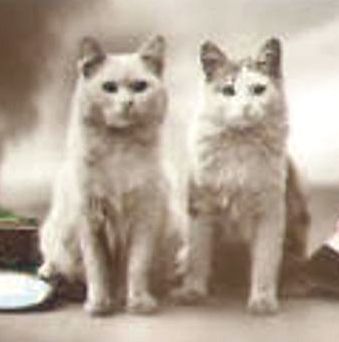
This vintage photo is not of Buster and Topsy, but it’s how I imagine they may have looked had the two feline mascots actually liked each other (and had Topsy lost some weight).
Part I: Buster and Topsy, the Rival Police
Cat Mascots
On the evening of December 6, 1911, the men of the old Eldridge Street police precinct in New York City’s Lower East Side moved into the brand-new station house occupied by the men of the old Delancey Street precinct.
The large modern building at the corner of Clinton and Delancey streets, with dormitory quarters for 250 men, was more than adequate to accommodate everyone. Everyone, that is, except for Buster and Topsy, the two rival police cat mascots.
In other words, when the two stations merged peacefully, the feline mascots refused to do the same.
Buster, a small black and white male cat, was on the job with the Thirteenth Precinct on Delancey Street. Topsy was a very large white female cat attached to the former Tenth Precinct on Eldridge Street. When the two precincts came together and Topsy moved into her new digs on Clinton Street, little Buster got the short end of the stick.
During their first month in the new station house at 118 Clinton Street, Buster spent most of his time on the streets living the life of a peddler. Meanwhile, as The New York Times reported, Topsy “grew bigger and fatter on the choice fare of the police station whose chief catship she had successfully usurped.”
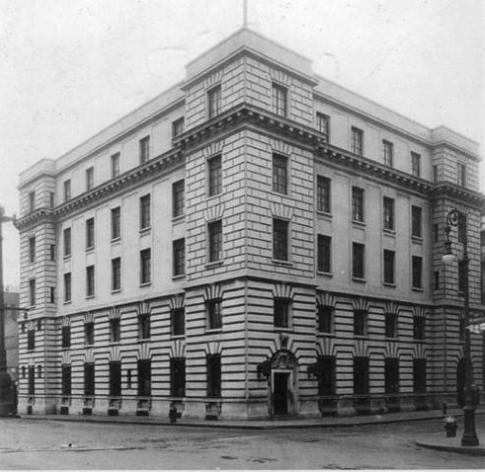
The station house at 118 Clinton Street was designed by city architect Edward Pearce Casey. Built of solid concrete block and finished with stucco on the interior, the large building cost the city $165,000 when it was constructed in 1909.
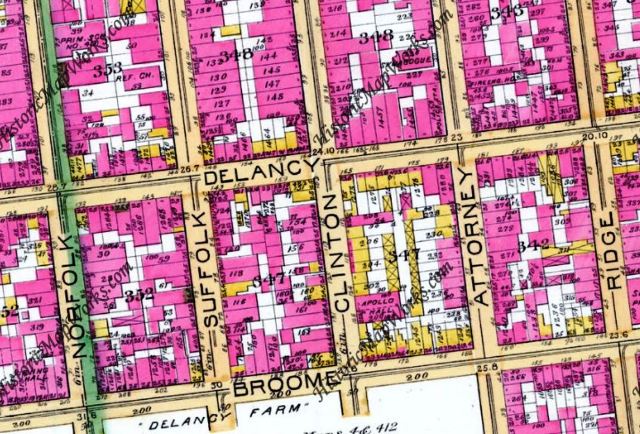
The new station house at 118 Clinton Street replaced an entire block of old frame tenements, many of which had stables in the rear lots, as denoted by the yellow boxes with an “X” in this 1891 map. This part of the Lower East Side was originally the farm of Lieutenant Governor James De Lancey, Sr.
The Old Thirteenth Precinct Station House on Delancey Street
Prior to moving to the station on Clinton Street in 1911, Buster lived with his police protectors in a Civil War-era station house at 178 Delancey Street, on the northwest corner of Attorney Street. Although this station house had been reconstructed numerous times, it was considered one of the oldest police stations — if not the oldest — in New York City.
According to city records, the city purchased the 25 x 100 foot lot at the corner of Delancey and Attorney streets in 1814 from John R. Linngsten for $1,000. In these early years, 178 Delancey Street was used as a public meeting place for residents of the neighborhood.
By 1823, there was a small firehouse on the site that was home to Clinton Engine No. 41 (more familiarly known as “Old Stag”) and Hook and Ladder No. 5 of the city’s volunteer fire department.
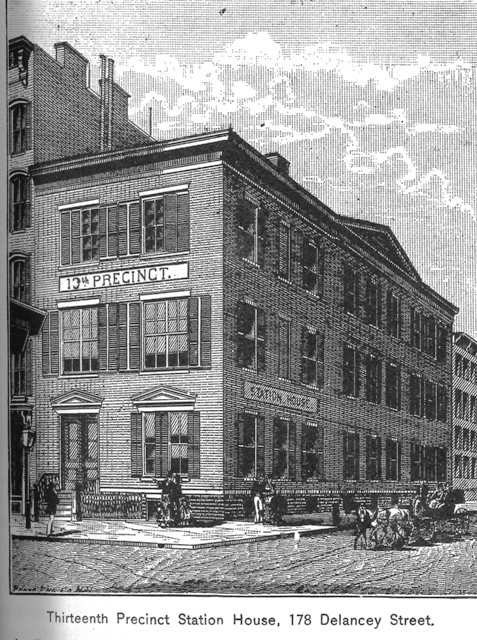
By the late 1800s, 178 Delancey Street had been reconfigured numerous times. When this illustration was made, probably in the 1890s, the Thirteenth Police Precinct was the only organization that occupied the building.
Sometime around 1826, a relief watch house for the city’s Second Watch District was erected in the rear of firehouse. The men assigned to this watch house were responsible for protecting the streets at night, and, in particular, looking out for fires in the neighborhood.
In 1831, the city’s new Fire and Building Department called for a new two-story brick building to better accommodate the volunteer engine and ladder company. The plan was to house the fire apparatus on the first floor and to rent the second floor.
According to city records, during the l830s and early 1840s, the second floor was occupied by Public Primary School #7.
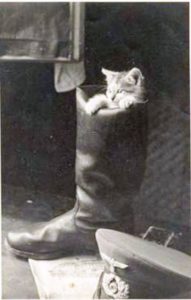
This police cat isn’t Buster either, but I just love this photo and it could have been Buster…
This two-story building allegedly had a tower with a cupola to house the watch house. In 1833, the city installed a bell in the cupola.
Reportedly, the two men assigned to look for fires at night would give the alarm by ringing the bell and hanging a pole out the window. The pole had a lantern on the end, which the men would point in the direction of the fire.
In 1845, the Municipal Police replaced the old night watch system. The Municipal Police was divided into three police districts, each comprising 5 to 6 wards.
The Thirteenth Ward moved into 178 Delancey Street in 1848, sharing its headquarters with the volunteer engine and ladder companies. (The school moved to 56 Chrystie Street.) In a house next door, one of the city’s earliest police courts was held.
By the early 1900s, the old building at 178 Delancey Street was no longer fit for a station house. There was not enough room to properly accommodate all the men, and the underground prison cells had been cited for code violations by the Board of Health.
Thus, in 1911, the men and cat of the Thirteenth Precinct moved into the large concrete building on Clinton Street, where they were joined soon thereafter by the men and cat of the old Tenth Precinct.
The New Bridge Theatre, managed by Max Rothbart and Gordon, moved into the police station a year later. (The movie theater created quite a stir when it advertised a movie showing actual scenes of the Herman Rosenthal murder in 1912). In May 1917, the city sold the building to the Salem Land Company in exchange for a large plot of land that the company owned on Inwood Hill.
Buster’s Unhappy New Year
On New Year’s Day, 1912, some of the policemen found poor Buster mewing miserably in some mud on Clinton Street. They brought him back to the station house where they washed him with what The New York Times called “well-intentioned but almost fatal vigor.”
When he was dry, they hung a small placard on him that read: A Happy New Year to All!
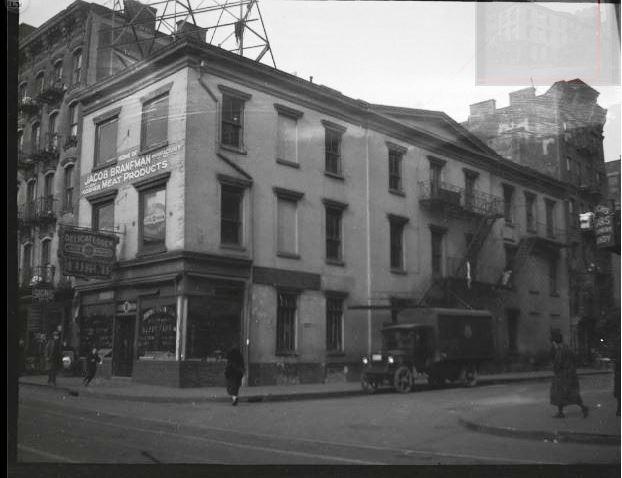
In 1924, the old Thirteenth Precinct police station house at 178 Delancey Street was occupied by Jacob Branfman’s delicatessen. New York Public Library Digital Collections
The men then led the small cat into the main assembly room, where he was treated to a large bowl of milk. Buster was in the midst of this meal when his rival, Topsy, woke from her nap on Lieutenant Jones’ desk. She jumped off the desk, spilling a bottle of ink all over the lieutenant in the process.
I don’t know what the two cat mascots said to each other (as the owner of two cats I can sort of guess), but later that night a special alarm went out to search for a small black and white cat last seen moping on Clinton Street and wearing a Happy New York sign on his back. By midnight, when he hadn’t been located, the policemen started to spread rumors that Buster had killed himself.
Sadly, there are no reports of Buster’s return. Topsy was reportedly thrilled at the turn of events.
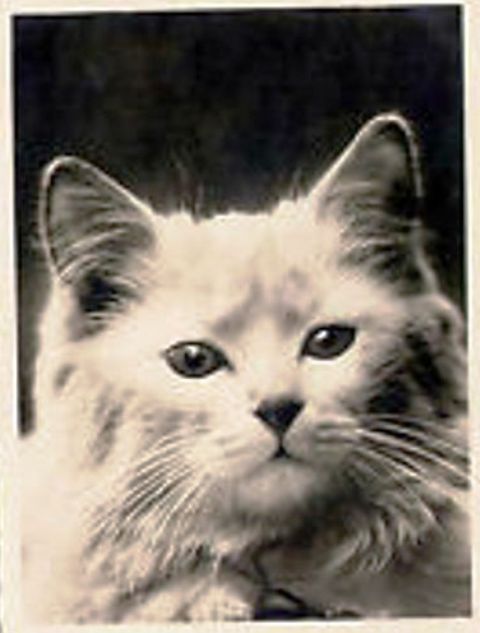
Topsy was pleased as punch to be the queen without a king at the new Thirteenth Precinct station house. (This is not Topsy, but it could be…)
In Part II of this NYPD cat mascots tale, we’ll meet Yaller the amazing mascot police dog and visit his historical station house on Eldridge Street.
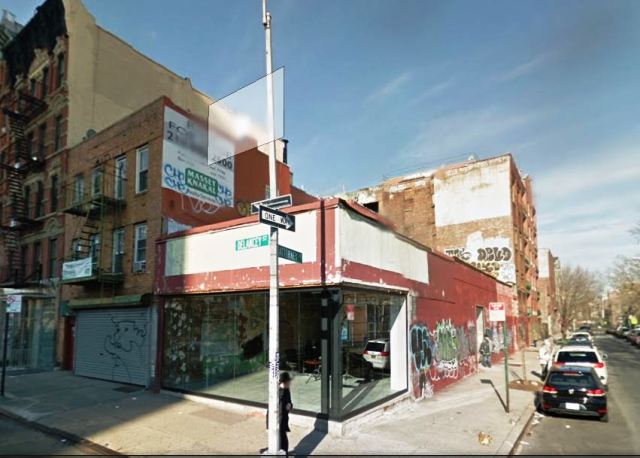
All that’s left of 178 Delancey Street is a vacant, one-story commercial building covered in graffiti. (The building lost its top 2 floors sometime prior to 1942.)



Poor Buster! Fascinating history, as always.